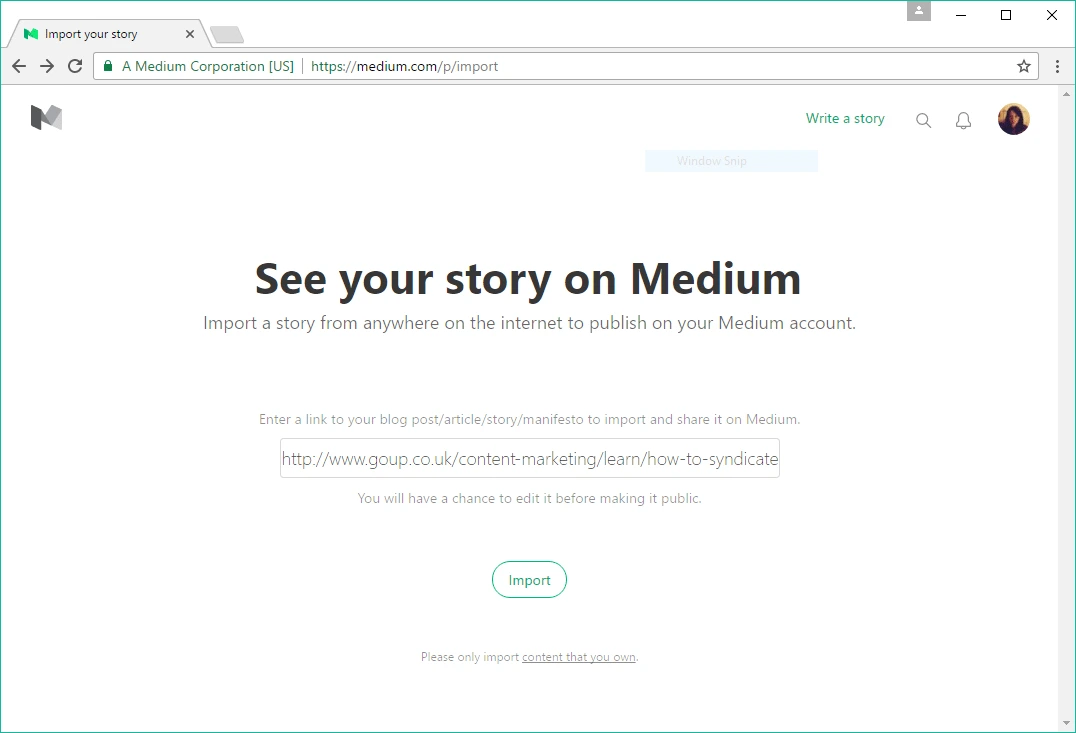
4 mins
OpenContent Marketing In The Time of COVID-19
8 mins
If you’re writing for a blog, guide or webpage, you need that content to actually reach people. But how can you be sure you’re still reaping the SEO benefits of republishing your high-quality content elsewhere?
20th April 2017

How can you be sure you’re still reaping the SEO benefits of republishing your high-quality content elsewhere?
If you’re producing content on a regular basis, you should be doing so with an ambition to consolidate your authority on a given topic, and make your company website a go-to source of information. But if you’re writing for a blog, guide or webpage, you need that content to actually reach people.
Whether you’re bringing readers in through a successful content marketing plan, a loyal social media following or a hefty list of subscribers, the influence of your content doesn’t have to be restricted to the confines of your own domain. You can get your content—and your brand—to reach new audiences by republishing your on-site content off-site on other platforms.
How can you be sure you’re still reaping the SEO benefits of republishing your high-quality content elsewhere? Well, we can start by syndicating our content and ensuring our own domain gets the full benefit. Let’s take a look at what that means.
Content syndication on the web is the term we use to describe content that is made available from one website to another site.
Generally, syndication is about republishing content in full, with attribution to the original content source. You’ve probably seen it on big-name web publications like The Huffington Post, Business Insider, Entrepreneur and Forbes. It might look like this:

Social media platforms like Facebook have reinterpreted the syndication model for social media with Instant Articles—providing a route for content to reach new audiences on the platform.
It’s win-win: while the host publication gets more quality content for its readers, you create backlinks to your site, which helps build brand recognition online. That’s brand recognition from Google, which by the power of link juice determines whether a domain is relevant and authoritative enough to rank highly in SERPs. This is based on the number and quality of links it receives from other sites.
It’s also brand recognition from humans, which works a bit like PR. That’s because actual human readers will, by associating your brand with quality and informative content, be more inclined to trace it back to the source: that’s your website.
Content syndication for the purposes of earning backlinks is similar to guest posting, but there are differences:
Both types allow you to include a backlink to your own domain, earning referral traffic and precious link juice. But only syndicated content credits your site as the location of the original content.
So, you ‘copy’ + ‘paste’, and you sit back and watch the traffic roll in, because you replicate good content anywhere and everywhere you can, right?
Take this example of an article recently published by CNBC. American Entrepreneur Mark Suster shares his thoughts on being asked why he chose not to invest in Snapchat. The post byline is attributed to Suster, and it makes mention of his company: Both Sides of the Table:

For all intents and purposes, it looks like a guest post. But when we scroll to the end of the article, we discover it is in fact syndicated content:

This is a direct link to the original content on Suster’s own site. Not only has this post earned valuable brand awareness, but it’s also given its readers more reason to explore the original content and site further. The Both Sides of the Table domain is meanwhile winning link juice from a high authority site like CNBC because of this link.
It’s win-win: while the host publication gets more quality content for its readers, you generate more traffic to your site and better establish your brand online.
Beyond that, content syndication is scalable while guest posting is not. Content, once published on your blog, can be republished any number of times elsewhere as syndicated content with attribution to your site.
So, you ‘copy’ + ‘paste’ to independent news and blogging platforms, as well as your business’s LinkedIn profile and you sit back and watch the traffic roll in, because you replicate good content anywhere and everywhere you can, right?
Well, a potential drawback for content creators is that they relinquish control over the presentation of their content when they syndicate it to other parties. Furthermore, unless you’re syndicating your content properly, you’re just duplicating content.
Duplicate content refers to blocks of content either within a domain or across different domains that are either overly similar or identical to one another.
Mostly, there’s nothing malicious to this practice. Say, for example, you’re an online retailer of Native American craft products, and each product listing includes a note on the region where the craft originated.
However, in some cases, content is deliberately duplicated across domains in order to manipulate search engine rankings or win more traffic to a site. Typically, it results in a poor user experience, because visitors see substantially similar content replicated across search results.
In cases where Google perceives duplicate content is published with the intention of manipulating those rankings, the engine makes adjustments in the indexing and ranking of those sites involved, including the domain where it was published first.
From the lion’s mouth: “As a result, the ranking of the site may suffer, or the site might be removed entirely from the Google index, in which case it will no longer appear in search results.”
Google is aware that duplicate content is sometimes published maliciously, but sometimes not, so the search engine does not penalise sites for duplicate content. It can, however, be detrimental to your website’s position in SERPs if you do not indicate which version of your content you want Google to prioritise.
In order to index only those pages with distinct information, Google has an advanced filter which, assuming you haven’t told Google’s crawlers otherwise, chooses which version of a duplicated article to list.
make sure Google knows which is the ‘preferred’ content URL by ensuring those who publish your syndicated material use the rel=canonical tag or noindex meta tag
If your domain contains multiple pages with largely identical content, such as ‘web’ and ‘printer’ versions of an article or guide, you can indicate to Google your ‘preferred’ URL using canonical tags. Read more in our guide to technical SEO.
But it’s not just about content on your own site. If you duplicate content on other sites, Google will always show the version it thinks is most appropriate in any given search, which may or may not be your original version.
In fact, it likely won’t be if the site hosting your republished content has a higher domain authority. All your hard work crafting over high-quality content can go to waste if the credit is being attributed elsewhere.
So the same applies: make sure Google knows which is the ‘preferred’ content URL by ensuring those who publish your syndicated material use the rel=canonical tag or noindex meta tag to prevent search engines from prioritising that version of the content.
Because the noindex meta tag removed the syndicated copy from Google’s index completely, the rel=canonical tag is preferable. It means you are both attributed as the original source of the content, but also tells the search engine to channel all the link metrics the syndicated copy attracts. This means that the syndicated copy will boost — not cannibalise — your SEO.
So long as you’re syndicating your content correctly, ensuring you’re not incurring indirect penalties for duplicating content, there’s no real reason not to syndicate your blog posts on external publishing platforms as often as you like.
If you’re looking to make it on the big-name sites we mentioned earlier, like Forbes, you’ll usually need to get yourself noticed by site editors before they agree to syndicate your content on their site. Catch their attention with a viral post, or building a relationship. A compromise: guest posting, then syndication once you’ve created a name for yourself.
If you’re keen to make a start on syndicating content, consider sites like Medium. Known as a platform for self-service syndication, it is a platform that allows anyone to publish original and syndicated content with your own author ID and attribution to the original source. It possible to give your content a little inaugural push with social media advertising, and the platform elevates the content it deems most interesting as ‘editor’s picks’.
You don’t have to worry about duplicate content either. Uploading your content via the special ‘Import a Story’ tool, Medium’s publication pathways automatically add canonical links to protect your original content posted offsite.

Tel Slack are one example of a business that syndicates most of their blog and news content on Medium. They have over 41k followers on the platform, which far exceeds the number of organic visits to their website’s own blog.
There are alternative sites, of course, but approach them with caution. LinkedIn and Quora pose a problem, for example, because there’s no way at the moment to add the rel=canonical tag or the noindex tag to republished content on the platforms.
The same strategy applies to syndicating content as it does to link building—only post your content to a site that is deemed relevant in context.
If you craft a relationship with a travel blogging platform, for example, and begin to syndicate content from your corporate wellness website on the topic of making the most of your annual leave, then it makes sense. But if you syndicate another blog about exercising in the workplace, that content and any backlinks to your site aren’t on topic within the context of travel. The practice is just spammy for both humans and search engines, which rank your site based partly on the relevancy of its inbound links.
be careful. You don’t want your readers to reap all the information they need about a topic on which your business is an expert without actually making a visit to your site.
You’ll also need to consider whether syndicating your content generates too many inbound links to your site from one source. In general, having a wider variety of domains linking to your site will have a more positive impact on SEO performance. Inbound links from different domains are more powerful than multiple ones from a single domain.
If you’re worried, you might wish to label backlinks as “nofollow” links. It tells search engines to ignore the link when evaluating the SEO strength of a site. This doesn’t mean that “nofollow” links are worthless. Even a “nofollow” link from a widely-read publishing platform or can drive plenty of human traffic to your site and strengthen your brand.
There is some debate among the SEO community as to whether hosting a blog on- or off-site is more beneficial to a website. If you include backlinks to your domain and/or service pages carefully using optimised anchor text, you can channel valuable link juice from the site that hosts your blog to your main domain.
There are examples of websites that exclusively publish blog content on external publishing platforms like Medium or Linkedin, or forums like Quora. Medium even supports bulk migration for single-author WordPress blogs to its site, and allows you to point a custom domain or subdomain to the network so you can link to your Medium-hosted blog from your own domain too.
Hosting your blog off-site definitely circumvents the duplicate content issue, and filters all your business’s posts into a larger pool of thematically-organised content and daily readership that far exceeds the readership of a blog on your own domain.
Other advantages include being able to write content with scope that isn’t strictly relevant to your business’s main offerings. Google’s Panda penalty will penalise a site for thin content, poor quality content, and content that isn’t at all relevant to your domain. But hosting that content on another domain largely mitigates the problem.
And hosting a blog on an external site increases your brand’s visibility by giving you a presence on another domain in SERPs. That’s especially good if your blog is hosted on a site like Medium that often takes up more real-estate in search for terms.
You might even use this strategy to promote your blog as a brand in itself: with the objective tone that affords you too.
Syndicating your content can help you reach new audiences and has SEO benefits in terms of channelling link juice to your site too. But be careful. You don’t want your readers to reap all the information they need about a topic on which your business is an expert without actually making a visit to your site.
There is no exact formula for how much of your content to syndicate, but it’s about finding a balance. You want to syndicate some of your best pieces to build a good reputation with a larger audience, but you also need high quality content which is unique to your site.
After all, one of the rewards of creating great content is bringing in visitors through long-tail search queries, and converting those readers into customers. If searchers find an answer to their query before they make it to your website, you’re missing out on valuable opportunities to expose them to any call to action buttons and branding that is part of your website design.
Don’t forget why you wrote that content in the first place: to get visitors to your website. If you’re syndicating or hosting your content in such as way as to make a visit to your website unnecessary, you’ve likely missed the point!